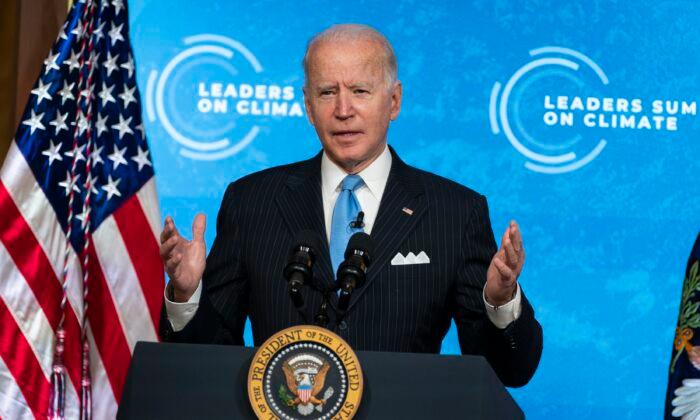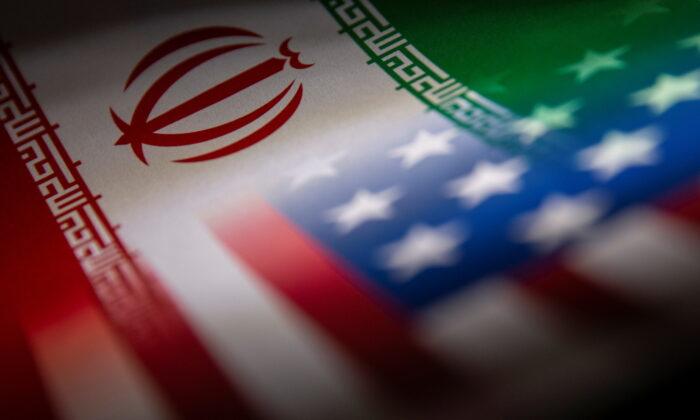News Analysis
President Joe Biden’s stance toward China hardened this month when he issued an executive order prohibiting American investment in Chinese companies that are developing advanced technologies that could be used by the military.
But a growing chorus of critics,
including some Democrats, argue that the administration’s effort to grapple with America’s foremost adversary is contradictory, illustrated in the White House’s Beijing-empowering pursuit of ambitious climate change goals.
Reducing greenhouse gas emissions to net zero by 2050, as the White House has called for, will almost assuredly make the United States dependent on China while enriching it.
China currently holds a commanding position in the clean energy industry, controlling the natural resources and manufacturing the components essential to the Biden administration’s desired alternative energy transition. Energy experts believe that its dominance will become more entrenched in the years ahead because of domestic environmentalist opposition to perceived “dirty” mining and refining operations and the Biden administration’s “clean energy” spending blitz—which could provide Chinese companies and subsidiaries billions in subsidies.
The Biden administration also considers it imperative to get buy-in from Beijing on dramatically reducing emissions, given it produces more than a quarter of all greenhouse gas emissions globally.
This, too, gives critics of the Biden administration’s green agenda pause. They see China as an unreliable partner that will leverage the Biden administration’s desire for it to go green to its own advantage.
“China,”
said Sen. John Barrasso (R-Wy.), ranking Republican member of the Senate Energy and Natural Resources Committee, “is playing us for suckers.”
Red China’s Green Dominance
China’s alternative energy clout comes from its command over
supply chains that culminate in the production of wind turbines, solar panels, and lithium-ion batteries on which the net zero transition depends.
On top of its own large domestic reserves, it has invested in mines worldwide and grown into a global hub for raw material refining and processing. China underscored this point on the eve of Treasury Secretary Janet Yellen’s July visit, when it imposed export restrictions on gallium and germanium, rare earth metals not only critical to the manufacture of semiconductors but also found in electric vehicles (EV) and solar panels.
According to the
U.S. Geological Survey, China is the leading producer of 30 of 50 minerals, including rare earth metals, that the U.S. government deems critical, particularly for their usage in energy technologies.
Rare earth metals are integral to the magnets that are key to electric vehicle motors and wind turbines. America is 95 percent net import
reliant on such materials, which China produces 70 percent of globally. According to the
International Energy Agency, the People’s Republic of China dominates “across the [rare earth] value chain from mining to processing and magnet production.”
Other
critical minerals for clean energy technologies include copper, key to solar cells; wind turbines; electric vehicles; cobalt, key to lithium-ion batteries; nickel, also key to such batteries and in renewable energy storage; and lithium itself. China is the world’s
largest refiner of all these minerals and produces 50 to 70 percent of all lithium and cobalt globally. The United States has no refining capacity for many of the same materials.
In analyzing the International Energy Agency’s authoritative “Net Zero by 2050” roadmap, the Energy Policy Research Foundation concluded, in a
report supported by the RealClearFoundation (which also funds RealClearInvestigations), that “replacing oil and gas with metal-intensive renewables and batteries risks further reinforcing China’s dominance in these critical minerals, at the expense of the energy security of most of the world.”
Research shows the following:
- Ten of the top 15 global wind turbine manufacturers are Chinese.
- China’s share in each of the five key manufacturing stages of solar panels exceeds 80 percent.
- China dominates in every aspect of the lithium-ion battery value chain—the batteries that power electric vehicles and battery storage power stations.
To put China’s clean energy dominance in perspective, as BloombergNEF
reported, while “Saudi Aramco pumped some 11 percent of the world’s crude in 2021 ... that pales before the 70 percent of production capacity in 11 clean energy segments nestled within China’s borders.”
“By cultivating leadership in clean energy technologies,” the U.S.-China Economic and Security Review Commission has
assessed, “Beijing is seeking to profit from a global clean energy transition while further deepening its geoeconomic leverage.”
Some lawmakers are concerned that China might hold such leverage over President Biden himself. In 2021, The New York Times reported that Hunter Biden had “helped secure cobalt for the Chinese” in 2016, while his father was vice president. House Republicans were
reportedly investigating this matter as of March, and the issue could resurface in connection with a potential impeachment inquiry into the Biden family’s alleged international influence peddling.
Biden’s Green Energy Blitz—And Its Limits
Acknowledging China’s alternative energy prowess, and therefore America’s dependence on Beijing to hit its green targets, the Biden administration has
pushed legislation—including the Inflation Reduction Act (IRA), which allocates $369 billion in green subsidies and incentives, as well as the Bipartisan Infrastructure Law, which commits still billions more—and sought to use its
executive authority and
regulatory power to build America’s alternative energy infrastructure.
The White House touts
$3 billion in federal grants for expanding the manufacturing of batteries for electric vehicles and the grid, $50 million in funding for wind energy research and development, and $35 million more in funding for Las Vegas-based MP Materials to establish an end-to-end magnet supply chain.
All told, the Biden administration
says it has committed some $22 billion in grants, rebates, and other initiatives “to accelerate the deployment of clean energy, clean buildings, and clean manufacturing.” It also takes credit for private sector investments of $133 billion in electric vehicles and batteries and $103 billion in clean energy. Still, experts say these measures leave America lagging behind China and that the aggressive goals set by the administration therefore require reliance on the communist power.
Mark Mills, a senior fellow at the Manhattan Institute and energy-tech venture capitalist, said the Biden administration’s efforts are “window dressing—maybe there’s a new term equivalent to ‘green washing’ along the lines of ‘mineral washing’—since there are no commensurate necessary regulatory changes for large-scale, chemically-difficult industries,” such as mineral refining, necessary to meaningfully ramp up the onshoring of clean energy.
Republican lawmakers likewise have criticized the Biden administration for imposing environmental
restrictions that they see as
hamstringing the president’s stated agenda by blocking domestic projects that would unleash key natural resources.
The U.S. Army Corps revoked a key permit for a major domestic nickel mining project in Minnesota, as recommended by the Environmental Protection Agency, on grounds that it might not comply with the water quality requirements of a sovereign tribe downstream of the project. The Biden administration has also been reticent to engage in seabed mining, with U.S. Special Presidential Climate Envoy John Kerry
indicating that the administration is “very wary of procedures that could disturb the ocean floor.”
Even if America overcame these environmental concerns and fast-tracked mining projects, it is not clear it could sustain a wholly domestic clean energy industry. Echoing an
emerging consensus among
experts from the right and the left, Cullen Hendrix, a senior fellow at the Peterson Institute for International Economics and nonresident senior research fellow at the Center for Climate and Security,
said, ”The idea that you can have a truly made-in-America supply chain for all of these minerals is a fiction.”
Certainly, Victoria Coates says, it cannot do so on the aggressive schedule that the Biden administration has set, which would require the creation of vast supply chains during the next few years. A former deputy national security adviser, and later adviser to the secretary of energy during the Trump administration, Ms. Coates told RealClearInvestigations (RCI) that home-sourcing desired clean energy technology not only would be “cost prohibitive,” but “I don’t know that we’d even be up and running by 2050, let alone implementing a transition that would impact carbon emissions.”
Therefore, says Ms. Coates, now helming the Heritage Foundation’s Davis Institute for National Security and Foreign Policy, America “can’t decouple from China in this process to get to that target on that time frame.”
RCI contacted trade groups representing the solar, wind, and electric industries present at a Treasury-led clean power generation
roundtable to ask them about the feasibility of decoupling from China and whether and to what extent meeting the White House’s green goals would redound to China’s benefit but did not receive any responses.
Mr. Mills said the massive increase in wind/solar/battery utilization required by the Biden administration would serve China’s “direct benefit.”
Asked by RCI in an email whether it was concerned that the clean energy transition would increase America’s dependence on and otherwise redound to the benefit of China, a State Department spokesperson replied, “No,” noting that the Biden administration’s policies “are all intended to revitalize American leadership in emerging technologies and supply chains, protect our national security, advance American competitiveness, and create well-paying, high-quality jobs at home.”
Neither the White House, Treasury Department, nor Mr. Kerry’s office responded to a series of related inquiries.
Conflicts and Contradictions
The fundamental question for the Biden administration, Ms. Coates asked, is “How much China is too much China?” White House Clean Energy Czar John Podesta hinted that the bar may be high. In March, he
told a renewable energy advocacy group that China would be a “big player” in the clean energy transition.
Mr. Podesta drew a
rebuke from fellow Democrat Joe Manchin. The West Virginia senator, who chairs the Senate Committee on Energy and Natural Resources, released a statement saying that “it is beyond irresponsible for someone speaking on behalf of the White House to not only condone but also advocate for sending American tax dollars to Chinese companies.”
Mr. Manchin said: “These words are especially concerning as rumors circulate about the Administration thoughtlessly considering opening up the EV credit’s eligibility beyond our free trade agreement partners and allowing the laundering of Chinese minerals and materials through Trojan horse agreements.”
While the White House seeks to go green in a way that reduces dependency on China, there also appear to be loopholes in Biden administration policies and its enforcement of them. One question is whether Chinese companies can benefit from subsidies under the Inflation Reduction Act despite the bill’s purported focus on building the American clean energy industry.
Critics such as the Coalition for a Prosperous America have highlighted six Chinese companies that have announced plans to partner with American outfits to assemble solar panels and other components domestically, making them eligible for an estimated $1 billion in U.S. tax credits.
This is also happening in the auto industry, where Ford recently announced a
partnership with Chinese company CATL to build a domestic $3.5 billion electric vehicle battery plant. There are also
growing concerns that the Treasury Department will loosely interpret
provisions of the Inflation Reduction Act aimed at limiting such credits to electric vehicles and solar panels comprised of components and minerals from America or its friends.
In March, the Treasury Department released the proposed regulations on electric vehicle credits, which included provisions that
critics saw as skirting the IRA’s intended domestic sourcing requirements for such cars. Mr. Manchin
called the guidance “a pathetic excuse to spend more taxpayer dollars as quickly as possible,” that “further cedes control to the Chinese Communist Party in the process.”
When Treasury issued guidance in May indicating that solar project developers would receive a 10 percent bonus tax credit for using solar panels manufactured in America—even if they contained foreign silicon wafers, some 97 percent of which are produced in China—it drew stern rebukes from several populist
Democrats.
This was not the first time that President Biden had run afoul of some in his party over solar panels. Weeks earlier, Congress sent a veto to the president’s desk calling on him to rescind a two-year moratorium on solar tariffs from Southeast Asian countries Thailand, Vietnam, Malaysia, and Cambodia. This was seen as a boon to Beijing, as Chinese entities had been found to be
circumventing more onerous tariffs by shifting their solar panel production to the neighboring countries.
After a dozen Democrats voted with Republicans to pass a resolution disapproving of the moratorium in the House, nine Democrats in the Senate did the same.
“The president got this one wrong,” said Sen. Sherrod Brown (D-Ohio).
“You can’t say you want American manufacturing to lead the world and then allow Chinese companies, subsidized always by their government, to skirt the rules and dump solar panels into the U.S.”
After President Biden vetoed the resolution. Congress failed to muster the votes to override the veto.
Another issue raised by critics is that because of the amount of money that the administration is doling out and the speed at which it is dispensing it, it is not carefully scrutinizing who the recipients might be—potentially to China’s benefit.
Republicans point to a $200 million grant made under the Energy Department’s Battery Manufacturing and Recycling Grants Program, a creation of the Bipartisan Infrastructure Law, to a company called Microvast as an example of this problem. Microvast’s battery production largely takes place in China, and by the company’s own admission, China “exerts substantial influence over” the firm. Facing a firestorm from Republicans, the Energy Department ultimately scrapped the grant—with Energy Secretary Jennifer Granholm admitting it had been subject solely to a “post-selection” review under a pilot vetting process, drawing their
ire.
The Department of Energy’s inspector general noted that the Biden administration had
appropriated about $84 billion to stand up more than 70 new programs in recent legislation—more than two times the Department’s total fiscal year 2022 budget.
New programs, the inspector general warned, “push funding through untested processes and newly designed and untested internal controls.” Combined with the speed at which the funds are moving out the door, the general warned that this creates “risks of fraud, waste and abuse.”
“The IRA—and, generally, intensified government support for domestic production—risks opening the door to a wave of Chinese efforts to coopt that support and the domestic players benefiting from it,” the Foundation for Defense of Democracy’s Emily de La Bruyère recently argued in
written testimony prepared for the U.S.-China Economic and Security Commission. ”Those efforts are particularly potent considering China’s existing industrial dominance in the sectors being prioritized by government action.”
Climate and the US–China Rivalry
“There’s simply no way to solve climate change without China’s leadership,” Secretary of State Antony Blinken said in a May 2022
speech unveiling the Biden administration’s approach to China.
As Mr. Kerry has said, “We could go to zero [emissions] tomorrow and the problem isn’t solved.”
Thus, the Biden administration has repeatedly stressed that as the world’s largest polluter, China, must go green and that cooperation on climate is essential. For its part, China has not only dramatically ramped up its production of coal plants but also serves as the largest underwriter of fossil fuel infrastructure globally, by way of its
Belt and Road Initiative. Chinese leader Xi Jinping
insists that the “method, pace and intensity” for China to achieve carbon neutrality—which the country claims it intends to hit by 2060—“should and must be determined by ourselves, and will never be influenced by others.”
“China is not a partner on the environment,” Rep. Mike Gallagher (R-Wis.), chairman of the House Select Committee on the Chinese Communist Party, has
said. “It is the No. 1 threat, globally.”
Views expressed in this article are opinions of the author and do not necessarily reflect the views of The Epoch Times.








